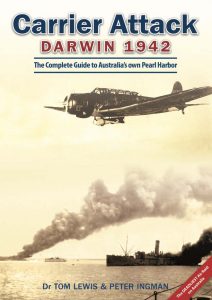- Author
- Book reviewer
- Subjects
- History - WW2, Book reviews, Naval Engagements, Operations and Capabilities
- Tags
-
- RAN Ships
- None noted.
- Publication
- March 2014 edition of the Naval Historical Review (all rights reserved)
Carrier Attack Darwin 1942: The Complete Guide to Australia’s own Pearl Harbor. By Dr Tom Lewis & Peter Ingram. Published by Avonmore Books, Kent Town, South Australia, 2013. Hardback, 368 pages with numerous illustrations and photographs many in colour, rrp $49.95.

Darwin on 19 February 1942 is a day that should be long remembered by Australians when one of the largest attacks by Japanese aircraft was delivered on a poorly defended relatively small outpost at the northern end of our nation. What is extraordinary about the scale and ferocity of this attack, mainly conducted by carrier borne aircraft, is explained in great detail in this fine volume. Why was the attack necessary, what was the strategic purpose, was this the prelude to an invasion of our shores? These and many more important questions are addressed. In the context of our national defence the lessons learned both then and extrapolated to the present should not be overlooked.
In setting the scene it should be remembered that this was one of our darkest hours. Within a period of a few months Pearl Harbor had been attacked with devastating effect, the Americans were forced to withdraw from the Philippines, the impregnable fortress of Singapore had been lost in a humiliating surrender with many thousands of Australian troops in captivity, the Dutch East Indies was set to fall and, Australian territories in New Guinea were about to be invested. The authors place all this into perspective and shows where Darwin fits into this vast and dynamic landscape.
The similarities and differences with Pearl Harbor are explained with the attack on the former mainly conducted using about 350 aircraft from six carriers whereas that at Darwin was from about 250 aircraft from four carriers supported by some land based naval aircraft. As four of the same carriers were used in both attacks those in the latter attack had prior experience and given the much smaller value targets at Darwin the attacks were of similar determined ferocity. A detailed analysis is undertaken using the latest information, some of which has only recently become available from Japanese sources. This provides details of the composition of the forces available to the Japanese and the tactics used by the carriers and their bombing and strafing aircraft. There are also details of the available defence forces both Australian and American together with a comhrenhsive list of the many ships in harbour at this time.
The results of the raids, one major wave from the carriers followed by a smaller wave from land based aircraft, are explained as are the actions taken by those on the ground, in the air and, by the various ships. As the number of witnesses to these historic events is now in serious decline it is timely that many myths and misconceptions as to actions taken, damage caused and the number of causalities are fully explored. The experienced authors seek to reach sound evidence based conclusions which provide many answers. These days it is a pleasant surprise to find an Australian published hardback of fine quality. In this case the publisher has done well; the generous text is adequately supported by copious illustrations and photographs, many in colour. For those seeking further detail there is a plentiful supply of appendices and the volume is well referenced and indexed. It is a book that should have wide appeal to anyone interested in Australian history as well as those with a taste for military history. It is also a fine book of reference with a vast amount of material cleverly pulled together into a single readable volume which should find its way to many bookshelves and libraries and will retain its value for many years to come.
Reviewed by Walter Burroughs




